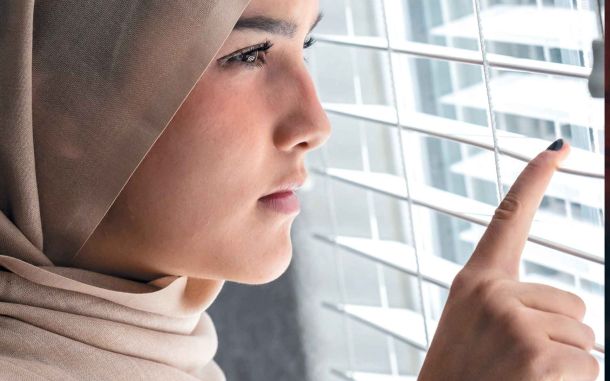Counseling Muslim-American Youth

In This Article
-
Research on Islamic Psychotherapy and incorporating Islamic principles into Western Psychotherapy to better counsel Muslim clients has been expanding over the past years.
-
Expanding the counseling practice to include interventions that focus specifically on Muslim adolescents’ mental health can help counselors increase their awareness, knowledge, and competence to better support this population.
-
Correlations between Islamic practices, Cognitive Behavior Therapy (CBT), and Mindfulness Based Cognitive Therapy (MBCT) suggest that utilizing integrative approaches in therapy can provide fruitful therapeutic results with Muslim clients.
A day thinking about what could happen, should happen, or what might have been is a day missed. #mindfulmoments
@HeadspaceThink of the present hour; your power of patient endurance is enough for this hour. Mobilize all your strength for [it], and think of divine mercy, reward in the hereafter, and how your brief and transient life is being transformed into a long and eternal form.
Said Nursi
Is it not surprising how a 2020 @Headpsace tweet on carpe diem and a 20th century Islamic scholar’s quote correspondingly focus on the present? Furthermore, both Headspace and Said Nursi stress the importance of moment-to-moment mindful attention, a part of mindfulness-based mental health intervention which is highly effective for anxiety. As a Muslim counselor in training, I have noticed correlations between certain Islamic practices and values advised in the the Quran and the Prophetic tradition, the Western Psychological Theory of Cognitive Behavior Therapy (CBT), and Mindfulness Based Cognitive Therapy (MBCT) inspired by Chinese spiritual practices. These correlations suggest that utilizing spiritually integrative approaches in therapy can provide fruitful therapeutic results with Muslim clients.
Though research on Islamic Psychotherapy and incorporating Islamic principles into Western Psychotherapy to better counsel Muslim clients has grown over the past years, there is very little focus on counseling Muslim adolescents. Expanding the counseling literature to include interventions that focus specifically on Muslim adolescents’ mental health can help counselors increase their awareness, knowledge, and competence to better support this population. This article explores the existing literature on Muslim adolescents and mental health counseling and highlights the use of psychoeducation when using innovative and integrative therapeutic practices to help Muslim youth cope with mental health issues.
A High-Risk Group for Mental Health Issues: Muslim-American Adolescents
According to the Pew Research Center (2020), the 3.45 million Muslims living in the United States make up about 1.1% of the population. Almost half of Muslims (48%) have experienced discrimination during the past year; this number used to be 43% in 2011, and 40% in 2007 (“U.S. Muslims Concerned”). Following the 2016 Presidential Election, Council on American-Islamic Relations reported hate crimes in the U.S. rising 91% in the first half of 2017 compared to 2016 (APA, 2020). FBI’s (2020) “2019 Hate Crime Statistics Report” indicates that 13.2% of hate crime victims were of anti-Islamic (Muslim) bias. As these statistics demonstrate, factors such as discrimination, bullying, profiling, Islamophobia, and hostility that Muslims face put them at risk for mental health problems. Muslims in the United States most commonly face depression and anxiety along with other psychological troubles (Herzig, 2016, p. 14).
One-third of Muslim-Americans in the U.S. are under the age of 30, making them the youngest faith group in the country (APA, 2020). Research alarmingly shows that challenges in integration, vulnerability to Islamophobia, and religious discrimination put Muslim youth at an even higher risk for mental distress (Samari, 2016, p. 1922). 42% of Muslim students in K-12 schools are victims of faith-based bullying and “the younger the age of exposure to harassment, the greater the likelihood of developing depression, anxiety, and post-traumatic distress” (APA, 2020). Acculturative stress leads to cases of withdrawal, anxiety, and depression among Muslim adolescents, affecting girls more specifically (Goforth et al., 2016, p. 205). A group of young adult American-born Muslims were asked about whether they perceived presence of anxiety in peers, to which 64% replied yes. However, only 20% had knowledge of their peers seeking treatment, most probably due to stigma around receiving mental health care (Herzig, 2016, p. 33). Nevertheless, researchers have found that though stigma negatively impacts active coping in Muslim-American youth, religious coping is positively correlated with active coping strategies. As such, they argue that effectively working with Muslim-Americans require counselors to maintain “religion as a central consideration in the counseling process to promote recovery” (p. 34). Despite such a clear picture of an adolescent group at risk for mental health issues and guidelines on how professionals can help them, very little research has been conducted on bringing religion and spirituality into counseling when working with Muslim-American youth.
CBT and Mindfulness from an Islamic Perspective
Cognitive Behavior Therapy is one of the most clinically proven and effective therapeutic models in treating different psychological conditions, most specifically stress and anxiety. Belonging to the third wave of CBT, mindfulness-based therapy is also a promising intervention for treating anxiety and mood problems in clinical populations (Hoffman et al., 2010). Research on using CBT with adolescents is not scarce, compared to the very few works published specifically on how MBCT can be used with the same population Shorey et al. (2015), conducted a study on the relation between moment-to-moment mindful attention and anxiety among young adults in substance use treatment. Moment-to-moment attention, one facet of mindfulness, is defined as “sustaining attention to what occurs in the present moment of daily life (p. 374). They found that moment-to-moment mindful attention was affected by panic and generalized anxiety (p. 376). As a result, the authors suggest moment-to-moment mindfulness practices with clients who cope with such problems.
One area of knowledge missing from Western Psychotherapy curriculum and practice is the Islamic tradition of Cognitive Restructuring (Islamic cognitive behavior therapy) which predates Albert Ellis (1962) and Aaron Beck (1976). Abu Zayd Ahmed ibn Sahl Balkhi (al Balkhi) was a ninth century psychologist, who was the first to suggest cognitive approaches for anxiety and mood disorders, focusing on “how to eliminate emotional disorders by simply concentrating on changing one’s inner thinking and irrational beliefs” and using therapeutic techniques such as relaxation, desensitization, rational cognitive therapy, and psycho-spiritual religious cognitive approach (Rassool, 2016, p. 143). In addition to the rich Islamic tradition of mental health wellness practices, daily mindfulness rituals and mindfulness values Muslims are familiar with, such as gratitude (shukr) and acceptance (tawakkul), can all be sources of healing for Muslim clients who are seeking therapy. As counselors, it is up to us as culturally competent professionals to increase our knowledge on how we can facilitate such healing.
Importance of Integrating Islamic Values and Practices to the Therapeutic Process
Though there have been works published on Islamically focused CBT, minimal research exists on specific integration models of Islamic based mindfulness practices into the counseling process. Dr. Abdallah Rothman, Executive Director of the International Association of Islamic Psychology and an LPC working at the intersection of Islamic spirituality and mental health practice, detailed how Islamic worldview can be practically and effectively integrated into psychotherapy. He (2018) noted, “I do not consider what I do as an integration of Islam into psychotherapy as much as I consider my practice of psychotherapy as a translation of concepts relating to the soul and to the healing from the Islamic tradition into the language of psychology within a therapeutic process” (p. 30). Though Rothman practices Islamic psychology himself, his techniques can be used with Muslim clients even if the counselor belongs to a different theoretical orientation. The interventions he describes include centering meditation exercises that focus on heart, tawbah and istighfar (asking for forgiveness and purification of heart from God), dhikr (remembrance) and prayers as relaxation homework assignments, and muraqaba/tafakkur (Islamic “meditation” where the focus is connecting with God).
Dr. Fyeqa Sheik (2018) authored the only article focusing specifically on utilizing an integrative psychotherapy approach when working with Muslim adolescents and children. Contrary to Rothman, Sheik’s therapeutic approach is “an integrative one in which the conceptualization and treatment are based on a Western psychotherapy approach with Islamic principles integrated into the treatment” (p. 223). Though Sheikh lists some points of conflict between CBT and Muslim’s religious worldview, she argues that CBT can be modified to be congruent within an Islamic framework (p. 215). Since religiously integrated CBT has already proven to be an effective tool for clients with anxiety (Vahidid-Motlagh & Kajbaf, 2011), creating Islamically based CBT interventions for Muslim clients can be highly effective. Some techniques Sheikh provides include modifying traditional CBT statements in an Islamic perspective, performing dua (supplication) to improve well-being, and salah (prayer) which helps focus one’s attention solely on the actions of salah rather than other wordy matters, similar to mindfulness techniques that help individuals be more conscious in the present moment (Sheikh, 2018, p. 216-219).
Considerations and Conclusion: Psychoeducation and Further Research
Other than what Drs. Rothman and Sheikh’s provide, the counseling literature lacks any other research on how therapists can use innovative and integrative interventions to help the Muslim youth in their wellness journey. More research is essential on the effectiveness of different techniques that can be modified and adapted when working specifically with Muslim adolescents and whether Islamically integrated psychotherapy proves to be fruitful with them. What can be key to aiding young Muslim clients’ wellness is to use psychoeducation within therapy sessions to highlight how many of the daily Islamic practices that they are already used to are, in essence, mindfulness-based practices that can help them cope with stress, anxiety, and other mental health issues. Personally, I plan to conduct quantitative and qualitive research studies on Muslim adolescent awareness about Islamic mindfulness practices and coping with anxiety. What must be kept in mind for these studies and interventions is the diversity of the Muslim population and individuality of clients’ levels of religious practice spirituality, even if they belong to the same religion.
In the recent years, Islamic scholars and Muslim mental health counselors have increasingly been calling attention to the healing qualities of mindfulness within an Islamic tradition. The first Islamic guided meditation application, Sabr (patience) came out in August 2020. It includes guided meditation sessions through an Islamic lens by Muslim therapists and professionals, spiritually uplifting courses, prayers, Quran recitations, and courses on many topics including gratitude, patience, purification of the heart, having hope, reducing anxiety, mindfulness, forgiveness, and more. Sabr has more than eleven thousand followers on social media, highlighting the popularity of Islamically focused wellness practices. Yaqeen Institute (2017) has published an in-depth infographic and article, “How to Be a Mindful Muslim: An Exercise in Islamic Meditation.” To better help Muslim adolescents cope with different mental health issues through therapy, counselors need to first increase their cultural knowledge and competence about Islamic practices that can be incorporated into therapy sessions, and then use psychoeducation to increase client awareness on how their religion, which can be a source of distress in the United States due to discrimination and racism, can also be their source of healing.
References
- American Psychological Association. (2020). Stress & trauma toolkit for treating Muslims in a changing political and social environment. psychiatry.org. https://www.psychiatry.org/psychiatrists/cultural-competency/education/stress-and-trauma/muslims.
- Federal Bureau of Investigation. (Fall 2020). Uniform Crime Report Hate Crime Statistics, 2019. U.S. Department of Justice, Federal Bureau of Investigation. https://ucr.fbi.gov/hate-crime/2019/topic-pages/victims.pdf
- Goforth, A. N., Pham, A. V., Chun, H., Castro-Olivo, S. M., & Yosai, E. R. (2016). Association of Acculturative Stress, Islamic Practices, and Internalizing Symptoms among Arab American Adolescents. School Psychology Quarterly, 31(2), 198–212.
- Herzig, B. (2016). (rep.). Young adult American-born Muslims and mental health: an exploration of attitudes, Challenges, and Needs (pp. 1–52). Keene, NH: Institute for Social Policy and Understanding.
- Hofmann, S. G., Sawyer, A. T., Witt, A. A., & Oh, D. (2010). The effect of mindfulness-based therapy on anxiety and depression: A Meta-Analytic Review. Journal of Consulting and Clinical Psychology, 78(2), 169–183.
- Pew Research Center. (2020, May 30). S. Muslims concerned about their place in society, but continue to believe in the American dream. Pew Research Center's Religion & Public Life Project. https://www.pewforum.org/2017/07/26/findings-from-pew-research-centers-2017-survey-of-us-muslims/.
- Rassool, G. H. (2016). Islamic counselling: an introduction to theory and practice. Routledge.
- Rothman, A. (2018). An Islamic theoretical orientation to psychotherapy. In C. Y. Al-Karam (Ed.), Islamically integrated psychotherapy: Uniting faith and professional practice. (pp. 25–56). Templeton Press.
- Samari, G. (2016). Islamophobia and Public Health in the United States. American Journal of Public Health, 106(11), 1920–1925. https://doi-org.ezproxy.montclair.edu/10.2105/AJPH.2016.303374
- Sheikh, F. (2018). Marrying Islamic principles with Western psychotherapy for children and adolescents: Successes and challenges. In C. Y. Al-Karam (Ed.), Islamically integrated psychotherapy: Uniting faith and professional practice. (pp. 208–228). Templeton Press.
- Shorey, R. C., Anderson, S., Lookatch, S., Moore, T. M., & Stuart, G. L. (2015). The relation between moment-to-moment mindful attention and anxiety among young adults in substance use treatment. Substance Abuse, 36(3), 374–379. https://doi-org.ezproxy.montclair.edu/10.1080/08897077.2014.935841
- Vahidid-Motlagh, L., & Kajbaf, M. B. (2011). The effectiveness of cognitive behavioral and religious cognitive therapy on anxiety in students. Journal of Behavioral Sciences, 5(3), 195-201.









